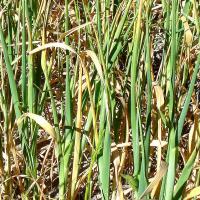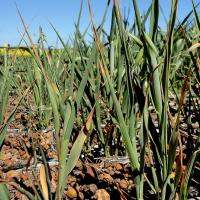Diagnosing spring drought in oats
Spring drought refers to plant water stress from insufficient rainfall or stored soil moisture occurring between tillering to maturity. Oats show symptoms more readily than wheat and barley.
What to look for
- Large areas of stressed or dying plants with some better plants in water gaining areas
- Low water holding soils, such as coarse sands and gravels, very shallow soil over rock or impermeable layer are more affected.
- Heavy clays that retain moisture near the soil surface after light rainfall where it is more likely to evaporate .
- Areas within the root zone of trees.
- Can be seen in double sown areas or areas of vigorous plants.
Paddock
- Plant wilting and becoming dull and discoloured
- Leaves furled and spiky.
- Old leaves develop yellow or orange colours, then necrosis on the leaf tip and extending down the leaf in broad stripes, and sometimes between veins until the leaf dies. Younger leaves are progressively affected.
- Shrivelled grain
Plant
What else could it be
| Condition | Similarities | Differences |
|---|---|---|
| Diagnosing water repellence | Water stressed plants | Only in water repellent soils |
| Diagnosing hostile clay loam to clay subsoil | Water stressed plants | Specific to poor susbsoils |
| Diagnosing root lesion nematode in cereals | Water stressed plants | 'Spaghetti root' damage |
How can it be monitored?
- Unless the problem is obviously due to drought, dig a hole and examine the soil profile for: Soil pH.
- Presence of restricting layers.
- Soil texture
See also
Page last updated: Friday, 10 July 2015 - 3:26pm





